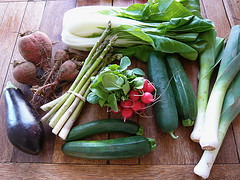10 Ways To Eat More Earth-Friendly

1) Organic versus Non-organic
It’s simple, really. Organic vegetables and fruits are not treated with growth hormones, and no pesticides or synthetic substances are used. While it’s healthy, consuming organic food is also great for the environment. According to downtoearth.org, it’s eco-friendly because it’s all natural.
2) Quinoa instead of Rice
According to the Huffington Post, huge amounts of fresh water go into farming of a rice grain. Oxfam says that “one-third of the world’s fresh water supply goes to rice production.” That’s insane! Switching to brown rice cuts back on processing, and quinoa is even healthier and high-protein than either of those options.
3) Whole Wheat instead of White
We all pretty much know that whole wheat toast is better for you than white, but do you actually know why? According to Kidshealth.org, bread is made from grain kernels that are basically wheat. A grain kernel includes the bran, the endosperm and the germ. White bread has bran and germ processed out, which only leaves endosperm - so basically starch. A whole lot of nutrients are erased. It’s better for the environment to eat wheat bread because it uses less refining.
4) Eat Less Meat
According to the Environmental Working Group, “if a family of four skips meat and cheese for an entire day each week, it’s like taking your car off the road for five weeks.” This doesn’t mean become a vegetarian, but skip meat on one day of the week to save the environment.
5) Grass-fed Beef instead of Grain-fed Beef
The Huffington Post suggests eating grass-fed beef because it takes less time and energy to grow grass than grow grains to feed the animals, and far less water and pesticides will be involved. Also, you’ll get a lot more nutrients and antioxidants out of it, while consuming less calories.
6) Shop at Farmer’s Markets
Food from Farmer’s Markets will require less time and energy getting to you. Also, many nutrients are lost during the processing and transporting. Less fuel will be used to transport your veggies. Reduce your carbon footprint and eat fresh!
7) Eat Raw
An article in Time suggests to eat your vegetables raw instead of using energy to sautee or cook them!
8) Watch your Fish
If you are a seafood lover, Time magazine urges you to read up on the fish you are about to buy before you do; if it’s partly endangered, leave it. Once again, local is best.
9) Save Water
If you are at a restaurant, ask for tap water instead of bottled, and buy a Brita or a filter for your H20 needs at home.
10) Skip the Fast Food
According to Woman’s Day, fast food comes with immense amounts of silverware, napkins and straws that are terrible for the environment. Also, the article cites a study that shows that a restaurant that makes four hamburgers emits the same amount of volatile compounds as a car would driving 1,000 miles.
Reach Staff Reporter Beatrice Verhoeven here. Follow her on Twitter.



